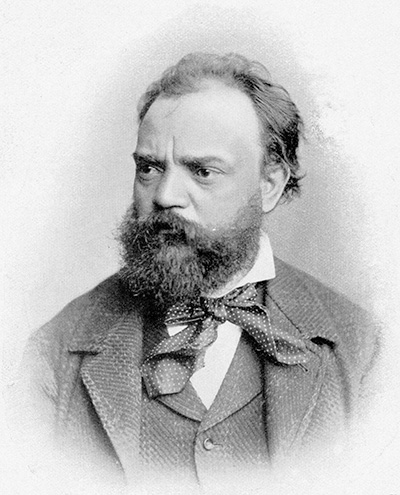Antonín Dvořák

Born: September 8, 1841, Nelahozeves, Bohemia
Died: May 1, 1904, Prague
Symphony No. 8 in G Major, Op. 88
- Composed: August 26–November 8, 1889
- Premiere: February 2, 1890 in Prague, conducted by the composer
- Instrumentation: 2 flutes (incl. piccolo), 2 oboes (incl. English horn), 2 clarinets, 2 bassoons, 4 horns, 2 trumpets, 3 trombones, tuba, timpani, strings
- CSO notable performances: First: January 1933, Eugene Goossens conducting. Most Recent: October 2014, Kazem Abdullah conducting. Recording: 1954, Thor Johnson conducting. Other: Iván Fischer conducting, 1991 and 1993.
- Duration: approx. 34 minutes
“Gentlemen, in Bohemia the trumpets never call to battle— they always call to the dance!”
(Czech conductor Rafael Kubelik during a rehearsal of the trumpet fanfare opening the last movement of Dvořák’s Eighth Symphony)
Something remarkable happened in the history of music during the 19th century: composers of symphonic music increasingly turned away from happy or cheerful feelings in favor of dramatic or even tragic ones. Instead of the light and unclouded tone found in many major works by Haydn or Mozart, Romantic composers predominantly used darker colors. Lightness was gradually pushed to the periphery of classical music and relegated to new popular genres (for instance, operetta), while large-scale symphonic works increasingly emphasized high passion and brooding melancholy.
There were two significant exceptions to this general trend: Mendelssohn in the first half of the century, and Dvořák in the second half. Both had the unusual gift of writing radiantly happy music in an era where such an approach was often taken for either conservatism or naïveté. It was neither; it was merely a sign of a different artistic personality.
If we compare Dvořák’s Eighth Symphony (1889) to some of the great symphonic works written around the same time, the difference will become readily apparent. In the previous year, 1888, Tchaikovsky completed his Fifth (E minor), in which he was grappling with grave questions about Fate and human life. The same year, César Franck introduced his Symphony in D Minor, whose complex emotional journey leads from self-doubt to eventual triumph. Johannes Brahms finished his fourth and last symphony (E minor) just a few years earlier (1885) with a magnificent passacaglia that infused that Baroque variation form with genuine Romantic passion. (Brahms’ ‟sunny” Second Symphony from 1877 is the exception that confirms the rule.)
Dvořák’s cheerfully optimistic Eighth opens with an expressive melody in G minor that prepares the entrance of another theme, a playful idea in G major first given to the solo flute. A dynamic sonata exposition soon gets underway. Dvořák ‟overshoots the mark” as he bypasses the expected secondary key, D major, in favor of a more remote but even brighter-sounding B major. The development section works up quite a storm, but it subsides when the playful main theme returns, now played by the English horn instead of the flute (two octaves lower than before). The recapitulation ends with a short but very energetic coda.
The second movement (‟Adagio”) begins with a simple string melody in darker tonal regions (E-flat major/C minor) that soon reaches a bright C major, where it remains. The main theme spawns various episodes, in turn lyrical and passionate. After a powerful climax, the movement ends in a tender pianissimo.
The third movement (‟Allegretto grazioso”) is neither a minuet nor a scherzo but an ‟intermezzo,” like the third movements of Brahms’ First and Second symphonies. Its first tune is a sweet and languid waltz; its second, functioning as a ‟trio,” sounds more like a Bohemian folk dance. After the return of the waltz, Dvořák surprises us with a very fast (“Molto vivace”) Coda, in which commentators have recognized a theme from one of Dvořák’s earlier operas. This Coda consists of the same notes as the lilting “trio” melody, only in a faster tempo, with stronger accents and in duple instead of triple meter. It is interesting that, in the third movement of his Second Symphony, Brahms had transformed his ‟trio” theme in exactly the same way.
A resounding trumpet fanfare announces the fourth movement (‟Allegro ma non troppo”), a complex theme-and-variations with a central episode that at first sounds like contrasting material but is in fact derived from the main theme. Dvořák’s handling of form is indebted to Beethoven and Brahms, but he filled out the form with melodies of an unmistakably Czech flavor and a joviality few composers at the time possessed. The ending seems to be a long time coming, with an almost interminable series of closing figures. When the last chord finally arrives, it still sounds delightfully abrupt due to its unusual metric placement.
—Peter Laki